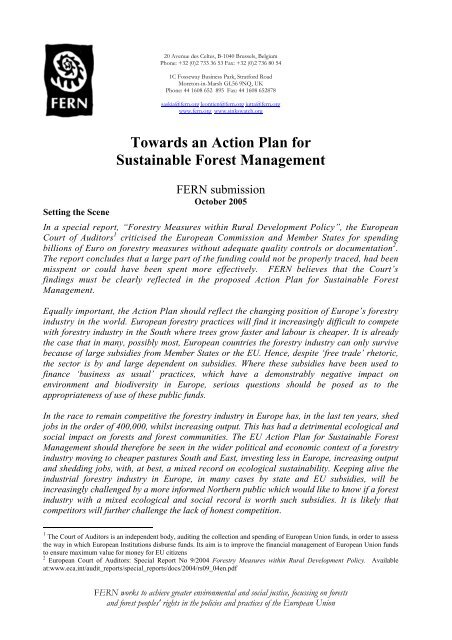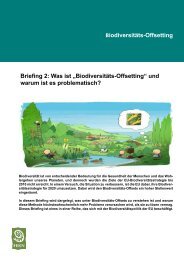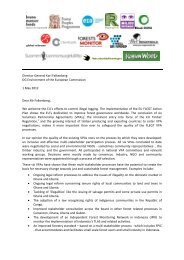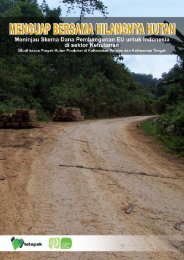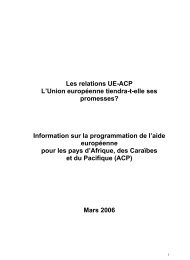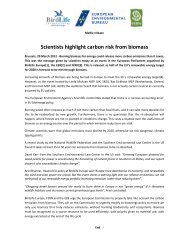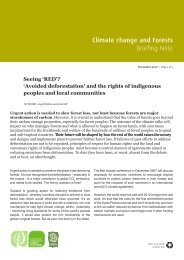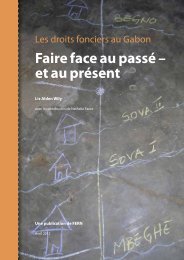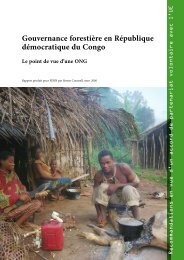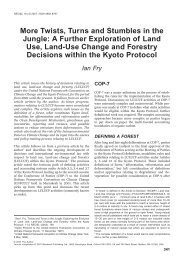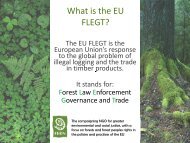Towards an Action Plan for Sustainable Forest Management
Towards an Action Plan for Sustainable Forest Management
Towards an Action Plan for Sustainable Forest Management
Create successful ePaper yourself
Turn your PDF publications into a flip-book with our unique Google optimized e-Paper software.
Setting the Scene<br />
20 Avenue des Celtes, B-1040 Brussels, Belgium<br />
Phone: +32 (0)2 733 36 53 Fax: +32 (0)2 736 80 54<br />
1C Fosseway Business Park, Strat<strong>for</strong>d Road<br />
Moreton-in-Marsh GL56 9NQ, UK<br />
Phone: 44 1608 652 895 Fax: 44 1608 652878<br />
saskia@fern.org leontien@fern.org jutta@fern.org<br />
www.fern.org www.sinkswatch.org<br />
<strong>Towards</strong> <strong>an</strong> <strong>Action</strong> Pl<strong>an</strong> <strong>for</strong><br />
<strong>Sustainable</strong> <strong>Forest</strong> M<strong>an</strong>agement<br />
FERN submission<br />
October 2005<br />
In a special report, “<strong>Forest</strong>ry Measures within Rural Development Policy”, the Europe<strong>an</strong><br />
Court of Auditors 1 criticised the Europe<strong>an</strong> Commission <strong>an</strong>d Member States <strong>for</strong> spending<br />
billions of Euro on <strong>for</strong>estry measures without adequate quality controls or documentation 2 .<br />
The report concludes that a large part of the funding could not be properly traced, had been<br />
misspent or could have been spent more effectively. FERN believes that the Court’s<br />
findings must be clearly reflected in the proposed <strong>Action</strong> Pl<strong>an</strong> <strong>for</strong> <strong>Sustainable</strong> <strong>Forest</strong><br />
M<strong>an</strong>agement.<br />
Equally import<strong>an</strong>t, the <strong>Action</strong> Pl<strong>an</strong> should reflect the ch<strong>an</strong>ging position of Europe’s <strong>for</strong>estry<br />
industry in the world. Europe<strong>an</strong> <strong>for</strong>estry practices will find it increasingly difficult to compete<br />
with <strong>for</strong>estry industry in the South where trees grow faster <strong>an</strong>d labour is cheaper. It is already<br />
the case that in m<strong>an</strong>y, possibly most, Europe<strong>an</strong> countries the <strong>for</strong>estry industry c<strong>an</strong> only survive<br />
because of large subsidies from Member States or the EU. Hence, despite ‘free trade’ rhetoric,<br />
the sector is by <strong>an</strong>d large dependent on subsidies. Where these subsidies have been used to<br />
fin<strong>an</strong>ce ‘business as usual’ practices, which have a demonstrably negative impact on<br />
environment <strong>an</strong>d biodiversity in Europe, serious questions should be posed as to the<br />
appropriateness of use of these public funds.<br />
In the race to remain competitive the <strong>for</strong>estry industry in Europe has, in the last ten years, shed<br />
jobs in the order of 400,000, whilst increasing output. This has had a detrimental ecological <strong>an</strong>d<br />
social impact on <strong>for</strong>ests <strong>an</strong>d <strong>for</strong>est communities. The EU <strong>Action</strong> Pl<strong>an</strong> <strong>for</strong> <strong>Sustainable</strong> <strong>Forest</strong><br />
M<strong>an</strong>agement should there<strong>for</strong>e be seen in the wider political <strong>an</strong>d economic context of a <strong>for</strong>estry<br />
industry moving to cheaper pastures South <strong>an</strong>d East, investing less in Europe, increasing output<br />
<strong>an</strong>d shedding jobs, with, at best, a mixed record on ecological sustainability. Keeping alive the<br />
industrial <strong>for</strong>estry industry in Europe, in m<strong>an</strong>y cases by state <strong>an</strong>d EU subsidies, will be<br />
increasingly challenged by a more in<strong>for</strong>med Northern public which would like to know if a <strong>for</strong>est<br />
industry with a mixed ecological <strong>an</strong>d social record is worth such subsidies. It is likely that<br />
competitors will further challenge the lack of honest competition.<br />
1 The Court of Auditors is <strong>an</strong> independent body, auditing the collection <strong>an</strong>d spending of Europe<strong>an</strong> Union funds, in order to assess<br />
the way in which Europe<strong>an</strong> Institutions disburse funds. Its aim is to improve the fin<strong>an</strong>cial m<strong>an</strong>agement of Europe<strong>an</strong> Union funds<br />
to ensure maximum value <strong>for</strong> money <strong>for</strong> EU citizens<br />
2 Europe<strong>an</strong> Court of Auditors: Special Report No 9/2004 <strong>Forest</strong>ry Measures within Rural Development Policy. Available<br />
at:www.eca.int/audit_reports/special_reports/docs/2004/rs09_04en.pdf<br />
FERN works to achieve greater environmental <strong>an</strong>d social justice, focussing on <strong>for</strong>ests<br />
<strong>an</strong>d <strong>for</strong>est peoples' rights in the policies <strong>an</strong>d practices of the Europe<strong>an</strong> Union
An <strong>Action</strong> Pl<strong>an</strong> focused on sound environmental values<br />
The Court of Auditors found that the current <strong>Forest</strong>ry Strategy assumes that its main objectives,<br />
economic, environmental <strong>an</strong>d social, are complementary but concludes that it is very difficult to<br />
obtain <strong>an</strong> appropriate bal<strong>an</strong>ce between these objectives 3 . In at least one Member State, the EU<br />
<strong>Forest</strong>ry Strategy was highly criticised as being overly focused on economic aspects without due<br />
regard to the need to maintain biodiversity. In fact Europe’s <strong>for</strong>ests are in dire straits; in most<br />
Europe<strong>an</strong> countries current <strong>for</strong>estry practices have lead to loss of biodiversity. A study by<br />
Pl<strong>an</strong>tlife 4 in Central <strong>an</strong>d Eastern Europe has demonstrated that poor <strong>for</strong>est m<strong>an</strong>agement is seen<br />
as the biggest threat to the wild pl<strong>an</strong>ts of Central <strong>an</strong>d Eastern Europe today. Despite statements<br />
from the <strong>for</strong>estry industry, that the ’<strong>for</strong>est area’ is growing, it is clear that the environmental<br />
quality <strong>an</strong>d health of Europe’s <strong>for</strong>ests is declining. As there is less scope <strong>for</strong> designating new<br />
sites <strong>for</strong> biodiversity conservation, due to growing <strong>an</strong>d conflicting pressures on available l<strong>an</strong>d, all<br />
sectoral policies, specifically <strong>for</strong>estry, have to integrate biodiversity concerns to halt further<br />
biodiversity loss in Europe 5 . If Europe’s <strong>for</strong>estry sector is to contribute to biodiversity<br />
conservation 6 some serious ch<strong>an</strong>ges in the <strong>for</strong>estry sector are required because current <strong>for</strong>estry<br />
practises contribute to bioidversity loss.<br />
• The EU <strong>Action</strong> Pl<strong>an</strong> must clearly spell out the ch<strong>an</strong>ges needed in the <strong>for</strong>estry sector in<br />
order to meet biodiversity dem<strong>an</strong>ds indicating how the EU intends to ensure the<br />
identification, protection <strong>an</strong>d enh<strong>an</strong>cement of biodiversity in the <strong>for</strong>ests within the EU.<br />
Current <strong>for</strong>estry practices, such as pl<strong>an</strong>ting of large areas as tree monocultures, often<br />
increase natural or m<strong>an</strong> made disasters such as storms <strong>an</strong>d <strong>for</strong>est fires which have a<br />
negative impact not only on the pl<strong>an</strong>tations but also on Natura 2000 areas 7 . The <strong>Action</strong><br />
Pl<strong>an</strong> should include clear timelines <strong>an</strong>d goals to demonstrate how the <strong>for</strong>estry sector<br />
c<strong>an</strong> minimise its negative impact on biodiversity <strong>an</strong>d detail the <strong>for</strong>estry measures<br />
needed to diminish the impact of natural disasters. The <strong>Action</strong> Pl<strong>an</strong> should also<br />
indicate the necessary measures to strengthen <strong>for</strong>est resilience in the light of climate<br />
ch<strong>an</strong>ge.<br />
• The <strong>Action</strong> Pl<strong>an</strong> should include clear timelines <strong>an</strong>d goals to demonstrate how to create a<br />
network of protected <strong>for</strong>ests as dem<strong>an</strong>ded in the EU Biodiversity <strong>Action</strong> Pl<strong>an</strong> <strong>for</strong> Natural<br />
Resources 8 . <strong>Forest</strong>s are a key natural ecosystem covering 35% of the l<strong>an</strong>d area in the EU.<br />
Fifty-nine <strong>for</strong>est habitat types, grouped in six <strong>for</strong>est habitat categories of Europe<strong>an</strong><br />
conservation interest, are listed in Annex I of the Habitats Directive because they are rare<br />
3<br />
Europe<strong>an</strong> Court of Auditors: Special Report No 9/2004 <strong>Forest</strong>ry Measures within Rural Development Policy. Available<br />
at:www.eca.int/audit_reports/special_reports/docs/2004/rs09_04en.pdf<br />
4<br />
Pl<strong>an</strong>tlife International (2005): Import<strong>an</strong>t pl<strong>an</strong>t areas in Central <strong>an</strong>d Eastern Europe – Priority Sites <strong>for</strong> Pl<strong>an</strong>t Conservation.<br />
Available at: http://www.pl<strong>an</strong>tlife.org.uk/IPAReport.htm<br />
5<br />
Europe<strong>an</strong> Environmental Agency; Signals 2004; Copenhagen 2004<br />
6<br />
The EU has committed to:<br />
• halt the loss of biodiversity by 2010 at the EU Summit in Gothenburg in 2001;<br />
• halt loss of biodiversity by 2010 in the Sixth Environment <strong>Action</strong> Programme (July 2002);<br />
• recommend priorities towards meeting the 2010 commitments, in the <strong>for</strong>m of a "Message from Malahide" in 2005;<br />
• halt loss of biodiversity under the Convention on biological Diversity (CBD), <strong>an</strong>d at the UN World Summit on <strong>Sustainable</strong><br />
Development in September 2002 in Joh<strong>an</strong>nesburg.<br />
7<br />
Fred Pearce (2005): Drought bumps up global thermostat. New Scientist 6 August 2005. Pg. 16<br />
8 EU Biodiversity <strong>Action</strong> Pl<strong>an</strong> <strong>for</strong> Natural Resources; COM/2001/0162final<br />
2
or residual <strong>an</strong>d/or hosting species of Community interest. The most signific<strong>an</strong>t reason <strong>for</strong><br />
species becoming end<strong>an</strong>gered is the loss of the most naturally diverse st<strong>an</strong>ds of <strong>for</strong>ests,<br />
such as old grown spruce <strong>for</strong>ests in Northern Europe. 9 At the moment only <strong>an</strong> average of<br />
1.6% of <strong>for</strong>ests in Europe are strictly protected. The <strong>Action</strong> Pl<strong>an</strong> should detail how to<br />
reach the objective, laid down in the EU Biodiversity <strong>Action</strong> Pl<strong>an</strong> <strong>for</strong> Natural<br />
Resources, of ensuring that Natura 2000 includes a coherent network of <strong>for</strong>est areas<br />
that c<strong>an</strong> maintain biodiversity at all scales in the long term.<br />
An <strong>Action</strong> Pl<strong>an</strong> focused on sound social values<br />
Current <strong>for</strong>estry practices are leading to serious job losses. Employment in the <strong>for</strong>estry sector in<br />
Europe has declined from 4.3 million in 1990 to 3.9 million people 10 in 2000. 11 The <strong>for</strong>estry<br />
sector is rapidly losing its status as a large employer, <strong>an</strong>d the trend is set to continue:. It is<br />
expected that by 2010 only 3.5 million people will be working in the <strong>for</strong>estry sector. This<br />
shedding of jobs has occured along with increased logging volumes. In Slowakia, <strong>for</strong> example,<br />
25,536 workers cut 5 276 000 m3 in 1990 whilst in 2004 7 268 000 m3 were cut by only 9 523<br />
workers 12 ; similar trends are discernible across the EU.<br />
There are also m<strong>an</strong>y other social values from <strong>for</strong>ests such as recreation <strong>an</strong>d the social value of<br />
non timber <strong>for</strong>est products (see below). In Northern Europe <strong>for</strong>ests provide livelihood to<br />
Europe’s last indigenous peoples, the Saami. The <strong>Action</strong> Pl<strong>an</strong> should clearly detail the rights of<br />
these peoples, to own or use the <strong>for</strong>est resources <strong>for</strong> reindeer herding, as laid down in several<br />
international Conventions <strong>an</strong>d agreements such as ILO Convention 169, the Coven<strong>an</strong>t of Civil<br />
<strong>an</strong>d Political Rights, which all EU Member States have ratified, <strong>an</strong>d also the P<strong>an</strong> Europe<strong>an</strong><br />
Operational Level Guidelines.<br />
• The <strong>Action</strong> Pl<strong>an</strong> should highlight the social <strong>an</strong>d socio-economic values of <strong>for</strong>ests<br />
<strong>an</strong>d present a clear <strong>an</strong>alysis of those values <strong>an</strong>d the benefits of <strong>for</strong>ests to society as a<br />
whole;<br />
• The <strong>Action</strong> Pl<strong>an</strong> should <strong>an</strong>alyse the downward trends in job creation <strong>an</strong>d how to<br />
reverse the trend or minimise its negative social impacts;<br />
• The <strong>Action</strong> Pl<strong>an</strong> should clearly state that recognition of local communities <strong>an</strong>d<br />
indigenous peoples’ rights is part of international commitments both the EU <strong>an</strong>d<br />
the Member States have signed up to.<br />
An <strong>Action</strong> Pl<strong>an</strong> focused on sound economic values<br />
It will be unsustainable, in the long term, to subsidise ‘business as usual’ practices as is currently<br />
the case in m<strong>an</strong>y Member States. Northern taxpayers will dem<strong>an</strong>d that public funds are spent<br />
9 Ilkka H<strong>an</strong>ski & Marcus Walsh (2004); How Much, How To? – Practical tools <strong>for</strong> <strong>for</strong>est conservation. Birdlife International,<br />
10 3.9 million people working in the <strong>for</strong>estry sector me<strong>an</strong>s 3.9 million fulltime jobs<br />
11 UNECE (2005); Europe<strong>an</strong> <strong>Forest</strong> Sector Outlook Study 1960-2000-2020. Main Report, Geneva<br />
12 Statistical Yearbook of the Ministry of L<strong>an</strong>d M<strong>an</strong>agement /Ministerstvo pôdohospodárstva<br />
3
appropriately. The Commission’s <strong>Action</strong> Pl<strong>an</strong> on <strong>Sustainable</strong> <strong>Forest</strong> M<strong>an</strong>agement must take<br />
account of ch<strong>an</strong>ging public opinion <strong>an</strong>d that, as the Court points out, the emphasis of Rural<br />
Development funding of <strong>for</strong>est related activities should now be on sustainable environmental<br />
benefits. Subsidies will be more acceptable if they support non-productive <strong>an</strong>d non-timber <strong>for</strong>est<br />
functions, if they support <strong>for</strong>est restoration rather th<strong>an</strong> contribute to biodiversity loss <strong>an</strong>d<br />
ecosystem degradation. With ch<strong>an</strong>ging public opinion, citizens will increasingly accept that<br />
timber output is the by-product. Ecosystem health <strong>an</strong>d <strong>for</strong>est resilience are the most import<strong>an</strong>t<br />
<strong>for</strong>est functions even if these may appear as uneconomical practices in the short term. This may<br />
well be the way Europe’s <strong>for</strong>ests need to go. Furthermore the economic <strong>an</strong>d social value of nontimber<br />
<strong>for</strong>est products should not be underestimated. Natural or semi-natural <strong>for</strong>ests contain<br />
mushrooms, cork, berries <strong>an</strong>d nuts, latex, t<strong>an</strong>nins, resins <strong>an</strong>d m<strong>an</strong>y other products. The economic<br />
value of these non-timber <strong>for</strong>est products in Europe, including CIS countries, was at least nearly<br />
5 billion Euro, in 2000, or 24% of the value of timber in these countries in 2000 13 .<br />
• The <strong>Action</strong> Pl<strong>an</strong> should include a section dealing specifically with the economic<br />
value of non-timber <strong>for</strong>est products;<br />
• The <strong>Action</strong> Pl<strong>an</strong> should include <strong>an</strong> overview of subsidies received by EU <strong>for</strong>estry<br />
industry to date;<br />
• The <strong>Action</strong> Pl<strong>an</strong> should develop ideas on how to create revenues <strong>for</strong> <strong>for</strong>est owners<br />
who w<strong>an</strong>t to use more environmentally friendly <strong>for</strong>est m<strong>an</strong>agement methods or<br />
restore degraded <strong>for</strong>ests 14 .<br />
An <strong>Action</strong> Pl<strong>an</strong> that clearly spells out the need <strong>for</strong> monitoring <strong>an</strong>d co-ordination<br />
The Court found that neither the Commission or Member States have assumed responsibility <strong>for</strong><br />
assessing whether a project contributed to the implementation of the EU <strong>Forest</strong>ry Strategy.<br />
There<strong>for</strong>e no adequate monitoring of projects or their impacts has been carried out. This was<br />
further compounded by the fact that monitoring systems were inexistent or failed to uncover<br />
questionable self-assessments provided by fund recipients. Applications exceeded the funds<br />
available but there were m<strong>an</strong>y weaknesses in the project selection procedures such as lack of<br />
clear criteria or the use of unverifiable criteria. The Court points out that this may have led to<br />
fraud with applic<strong>an</strong>ts claiming to have previously grown crops allowing the highest<br />
compensation rate (wheat) without checks existing to establish if this was the case. Or,<br />
applic<strong>an</strong>ts asking <strong>for</strong> the highest compensation, by claiming to be a farmer, whilst not always<br />
being required to prove this in<strong>for</strong>mation. Lastly no assessments were made on whether funded<br />
measures adequately reflected the three pillars of multifunctionality, economic, social <strong>an</strong>d<br />
environmental.<br />
13 UNECE (2005); Europe<strong>an</strong> <strong>Forest</strong> Sector Outlook Study 1960-2000-2020, Main Report, Geneva. These values may be even<br />
higher as much of the trade in non-timber <strong>for</strong>est products may not be captured in these statistics.<br />
14 Currently in m<strong>an</strong>y countries, specifically in Finl<strong>an</strong>d, the Finnish st<strong>an</strong>ding sale system is promoting destructive<br />
methods of <strong>for</strong>estry. This system gives <strong>for</strong>estry comp<strong>an</strong>ies a monopoly on buying <strong>an</strong>d harvesting timber, making it<br />
impossible <strong>for</strong> more environmentally friendly entrepreneurs to enter the market. As a result, there are no<br />
independent entrepreneurs <strong>an</strong>d no free competition in timber trade, logging or silvicultural services. Source: The<br />
Union of Eco<strong>for</strong>estry : ekometsa AT sci.fi<br />
4
• The EU <strong>Action</strong> Pl<strong>an</strong> should clearly detail how procedures could be put in place that<br />
would remove the vacuum of responsibility between the Commission <strong>an</strong>d the<br />
Member States so that it c<strong>an</strong> be guar<strong>an</strong>teed that EU funds will contribute to the<br />
objectives of the EU <strong>Action</strong> Pl<strong>an</strong>. This would also strengthen effective m<strong>an</strong>agement <strong>an</strong>d<br />
maximise the impact of EU funding on <strong>for</strong>ests.<br />
An upcoming issue: biomass<br />
The dem<strong>an</strong>d <strong>for</strong> wood based biomass <strong>for</strong> energy production in the EU is likely to rise<br />
subst<strong>an</strong>tially over the next 10 years. This will be the result of the EU <strong>an</strong>d Member States’ action<br />
to achieve their renewable energy <strong>an</strong>d Kyoto targets. There are as yet no ‘environmental targets’<br />
<strong>for</strong> biomass production.<br />
• The <strong>Action</strong> Pl<strong>an</strong> should declare how future biomass targets are in line with EU<br />
environmental commitments <strong>an</strong>d policies such as national biodiversity action pl<strong>an</strong>s,<br />
Habitat Directive <strong>an</strong>d Natura 2000.<br />
• The <strong>Action</strong> Pl<strong>an</strong> should indicate the need <strong>for</strong> a thorough assessment of how much l<strong>an</strong>d<br />
would be needed to fulfil EU biomass <strong>an</strong>d biofuel targets. Where such l<strong>an</strong>d is likely to be<br />
found should be <strong>an</strong> integral part of the <strong>Action</strong> Pl<strong>an</strong>. Early assessments indicate that<br />
fulfilling the biofuel dem<strong>an</strong>d of the UK car fleet would require using approximately 25.9<br />
million ha of arable l<strong>an</strong>d whilst in the UK only 5.7 million ha of arable l<strong>an</strong>d exists 15 . It is<br />
crucial, when considering the exp<strong>an</strong>sion of biomass <strong>an</strong>d biofuel use, that the <strong>Action</strong><br />
Pl<strong>an</strong> clearly identifies the area of l<strong>an</strong>d that will be needed to fulfil specific targets <strong>for</strong><br />
biomass <strong>an</strong>d biofuel energy <strong>an</strong>d outlines a set of considerations aimed at preventing<br />
<strong>an</strong> exacerbation of existing l<strong>an</strong>d use conflicts.<br />
15 Department <strong>for</strong> Environment, Food <strong>an</strong>d Rural Affairs, 2004. Agriculture in the UK 2003.<br />
5


